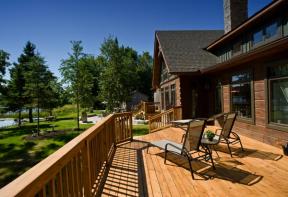Building the fifty-year deck
Avoid design flaws that can destroy your deck before its time
It’s easy to spend $10,000 or more on lumber for a deck, and depending on how you fasten that deck together, it could last anywhere from 15 years to 50. Which do you choose?
Giving your deck the best chance at a long life hinges on a few simple design details. And despite their modest appearance, these tricks can add many years to the life of your deck.
Rot is the single biggest deck killer, even if you’re using rot-resistant materials such as pressure-treated lumber, cedar or even an exotic deck wood species such as ipe. But rot doesn’t have to be inevitable, as long as you remain conscious of one thing: controlling moisture.
As you decide how the floor joists will be supported, how the beams will be constructed and how the decking will go down, ask yourself one question: how quickly will water drain away from this particular joint? If you minimize internal joint-drying time, you maximize deck life. It’s as simple as that. Trapped water accelerates rot dramatically, even in rot-resistant lumber.
Few professional deck builders pay attention to moisture traps because the market doesn’t reward this kind of diligence. But building your own deck offers the luxury of doing better in four of the most overlooked areas.
The first is in beam construction. While it may be easy to spike together three or four 2x8s or 2x10s to create deck-support beams, nothing pleases wood-eating microbes more. The spaces between each piece of lumber hold moisture for days, or even weeks, after it rains-perfect for kick-starting the rotting process. Instead of multiple pieces of wood spiked together, use pressure-treated beams instead. They last much longer because they don’t hold internal moisture. If you simply have to use multiple 2x planks side by side, separate them with vertical strips of composite lumber or pressure-treated ply.
Deck boards are another hot spot for rot, and they’re vulnerable in two ways. The first is end-to-end board contact. Moisture that gets trapped between the ends of tightly butted deck boards will wick into the wood through end-grain passages that used to carry sap. The result? Rot progresses unusually fast.
The solution here is to separate the ends of deck boards by 1/8″ to 3/16″ during installation, supported by double joists set 1/2″ apart. This allows the ends of deck boards to dry fast, while rainwater trickles down quickly between the joists.
Deck boards also trap a tremendous amount of moisture where they rest on the floor joists, although there are a couple of ways around the problem. One is a Canadian invention called RotNot (877-372-3019). It’s a system of plastic cap strips that snap tightly over the top edges of standard 2x lumber before the deck boards go down. The top of these strips are crowned and ribbed, so water drains quickly from beneath the deck boards. The plastic itself is also designed to seal tightly around each deck screw as it goes in, so water never touches the top edge of the floor joists.
Some hidden deck-fastener systems also promote deck board drainage by supporting each deck board so it touches underlying floor joists in only small areas. The FastenMaster IQ system (800-518-3569) uses clear plastic clips screwed to the underside of each deck board before it goes down. These clips raise deck boards about 3/16″ above the joists, for faster drying and longer wood life.
Couple these details with stainless-steel fasteners, and you’ll have a deck that costs a bit more up front, but will have a dramatically lower cost over its life because it lasts longer. All in all, that’s a very good deal indeed.
To leave a comment, please log in












No comments